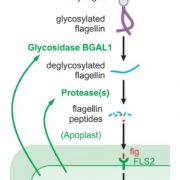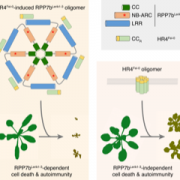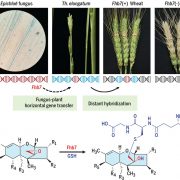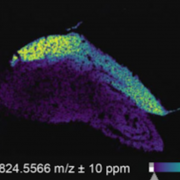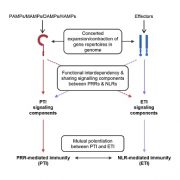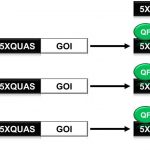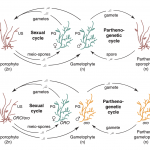Formation of NB-LRR receptor ZAR1 resistome in vivo ($) (Mol. Plant)
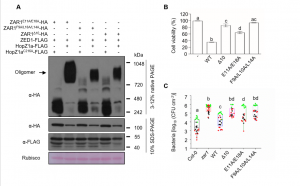 To fight against pathogenic microbes,plants have evolved intracellular nucleotide-binding, leucine-rich repeat (NB-LRR) receptors, known as NLRs, to monitor pathogen effector proteins and trigger robust immune responses. ZAR1 is a canonical NLR, and a forms a multimeric resistosome complex in vitro in association with partners and targets RKS1/PBL2/UMP/ATP. Now, Hu et al. have demonstrated that ZAR1 oligomerization is induced in vivo by the bacterial effectors AvrAC and HopZ1a. Moreover, the key residues for the in vivo HopZ1a-induced ZAR1 oligomerization and immunity are highly consistent with ZAR1-RKS1-PBL2UMP resistosome assembly in vitro. Furthermore, these same residues are essential for disease resistance, supporting a role for this complex in plant defense. (Summary by Nanxun Qin) Molecular Plant 10.1016/j.molp.2020.03.004
To fight against pathogenic microbes,plants have evolved intracellular nucleotide-binding, leucine-rich repeat (NB-LRR) receptors, known as NLRs, to monitor pathogen effector proteins and trigger robust immune responses. ZAR1 is a canonical NLR, and a forms a multimeric resistosome complex in vitro in association with partners and targets RKS1/PBL2/UMP/ATP. Now, Hu et al. have demonstrated that ZAR1 oligomerization is induced in vivo by the bacterial effectors AvrAC and HopZ1a. Moreover, the key residues for the in vivo HopZ1a-induced ZAR1 oligomerization and immunity are highly consistent with ZAR1-RKS1-PBL2UMP resistosome assembly in vitro. Furthermore, these same residues are essential for disease resistance, supporting a role for this complex in plant defense. (Summary by Nanxun Qin) Molecular Plant 10.1016/j.molp.2020.03.004
[altmetric doi=”10.1016/j.molp.2020.03.004″ details=”right” float=”right”]


